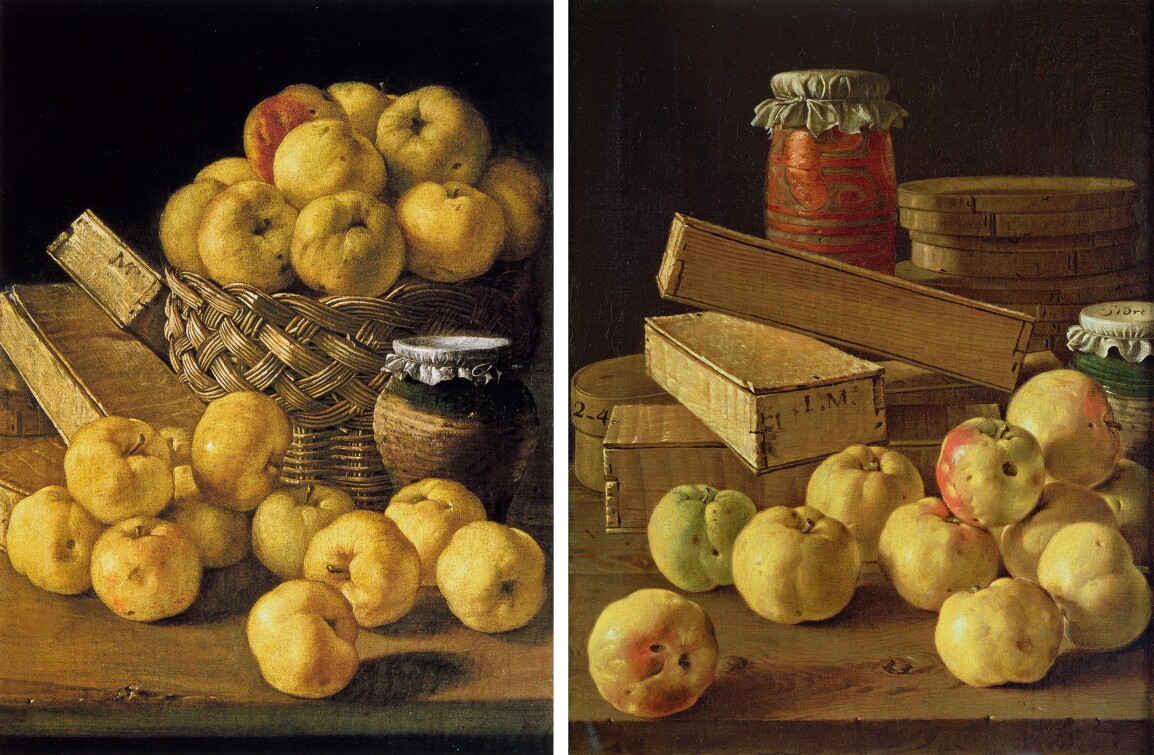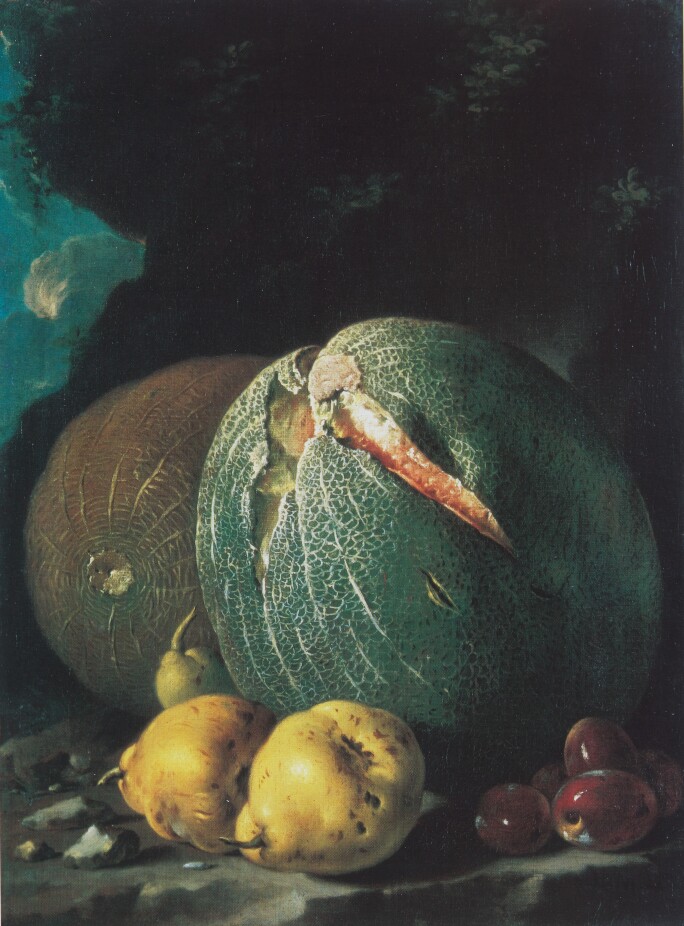This beautiful but humble bodegón epitomizes the style and qualities that made Luis Meléndez one of the greatest painters of still lifes in the eighteenth century. Typically, its subject is one of quiet simplicity, and consists of nothing more than a simple larder table. On its rough-hewn planks are a quantity of apples, some piled in a wicker basket, others strewn across the tabletop. Around them are piled boxes of sweetmeats, jellied fruits and cheese of varying shapes and sizes. In their midst stands a simple earthenware honey jar, covered with a simple cloth tied with twine. The mixture of the fruits and the kitchen utensils not only allows Meléndez to explore the contrasts between the brighter colours of the apples and the jar with the more neutral boxes, but also the differences in the textures of their rough and polished surfaces. The diagonals, circles and foreshortening of the seemingly effortlessly piled boxes provides an extremely subtle underlying rhythm and sense of depth to the composition. Meléndez renders these textures and forms with extraordinary skill, setting them all against a dark neutral background and defining them in a sharp but diffused light. In this simple but highly realistic style he continued and developed the tradition of Spanish still life painting established by his fellow countrymen Juan Sánchez Cotán (1560-1627) and Francisco de Zurbarán (1598-1664) in the previous century.
This combination of fruits, earthenware kitchen vessels and wooden sweetmeat boxes was evidently a favourite of the painter, and these elements recur in varying combinations in a number of his other paintings. The closest to the present picture in design and motif is the Still life with a basket of apples, sweetmeat boxes and a honey jar of identical dimensions formerly with Bernheimer in Munich and now in a private collection, in which a very similar tonality and spatial relationships are explored (fig. 1).1 Another very similar Still life with sweetmeat boxes, apples and honey jars, in which the woven basket full of apples is replaced by another honey jar, is also preserved in a private collection (fig. 2), and in which the form of the signature is the same as the present canvas.2 The individual box on the right of the painting here, upon which the letters M/SCA appear upside down, recurs again in another upright work, a Still life with fruits, watermelon, boxes and a wine bottle last recorded with Silvano Lodi in Campione d’Italia in Switzerland.3

Right: Fig. 2 Luis Meléndez, Still life with sweetmeat boxes and honey jars, 1760s, oil on canvas, 48 x 37 cm. Private Collection. © Sotheby’s
The similar vertical format and size shared by all of these paintings, with their densely arranged combinations of fruits and receptacles and common low viewpoint, is characteristic of Meléndez’s work of the 1760s and early 1770s, and Tufts suggested that they were all probably painted around this date. This was undoubtedly the period of Meléndez’s finest work, which anticipates the single most important commission of his career, the series of forty-four paintings executed between 1771 and 1774 for Charles, Prince of the Asturias (1748-1819) – the future Charles IV of Spain - for his new Cabinet of Natural History in the Palacio Real in Aránjuez, the royal summer residence outside Madrid.4 It is much less easy, however, to suggest a dating for individual works by Meléndez, for he does not seem to have dated any commissions outside of those for the Spanish royal house, and these therefore form the basis of any attempt to assess the development of his oeuvre. Meléndez constantly re-used or interchanged individual motifs in many of his works, but in general his earlier works tend to be compositionally more densely packed, and those of a later date are sparer, with the individual objects afforded more space. Many of his surviving paintings repeat compositions from the Asturias set and are therefore presumably of a later date in the 1770s, but for other works it is, as Cherry remarks, extremely difficult to establish a meaningful chronology.

The purported early history of this painting is shared with two other pictures, also of upright format: the first, a Still life with cauliflower, garlic, groceries and utensils was also formerly in the Schäfer collection in Schweinfurt, though not seemingly as a pendant to the present canvas,5 and the other, a Still life with melons, pears and plums is today in the Alte Pinakothek in Munich (fig. 3).6 The second of these was acquired from a private collection in London in 1963, and had reputedly been acquired by an English soldier or diplomat in Spain at the time of the Iberian campaigns of the Duke of Wellington between 1808 and 1814, and was later sold by his descendant, a prelate in the Church of England in the early 1960s. The other paintings are similarly undated but do not, however, form a coherent stylistic group, and the rare full signature of the canvas in Munich is quite different to those of its companions.7
Although Meléndez is now regarded as the greatest painter of still lifes or or bodegónes in eighteenth century Spain, he only began to specialize in still life painting in the 1760s, after his father’s dispute with the newly founded Academia de Bellas Artes de San Fernando in Madrid the previous decade had cut short his promising career as a portrait painter. Meléndez’s later attempts to gain royal patronage in the 1770s ended in failure, and though he is now recognised as the finest still life painter of his generation, he ended his life in poverty.
1 Canvas, 49 x 36 cm. Signed. Cherry 2006, p. 546, cat. no. 110, reproduced plate 110.
2 Canvas, 48 x 37 cm. Sold London, Sotheby’s, 13 December 1978, lot 63. Cherry 2006, p. 536, cat. no. 63, reproduced plate 63.
3 Canvas, 47 x 34 cm. Tufts 1985, pp. 93-94, no. 60, reproduced. Cherry 2006 p. 536, cat. no. 60, reproduced plate 60. Present whereabouts unknown.
4 See P. Cherry and C. Garrido, in Luis Meléndez. La serie de bodegones para el Principe de Asturias, exh. cat. Madrid, Museo del Prado, 2004, pp. 369-373 et passim. The series is now divided between the Prado, the Patrimonio Nacional and the Museo Nacional de Escultura, and comprises roughly a third of all Meléndez’s known work.
5 Canvas, 50 x 36.8 cm. Tufts 1971, p. 190, no. 78. Weniger 2005, p. 247, reproduced.
6 Inv. No. 13199. Canvas, 49.8 x 37.4 cm.
7 The signature form is Ls.Mz.Do. for Luis Meléndes de Ribera Durazo.